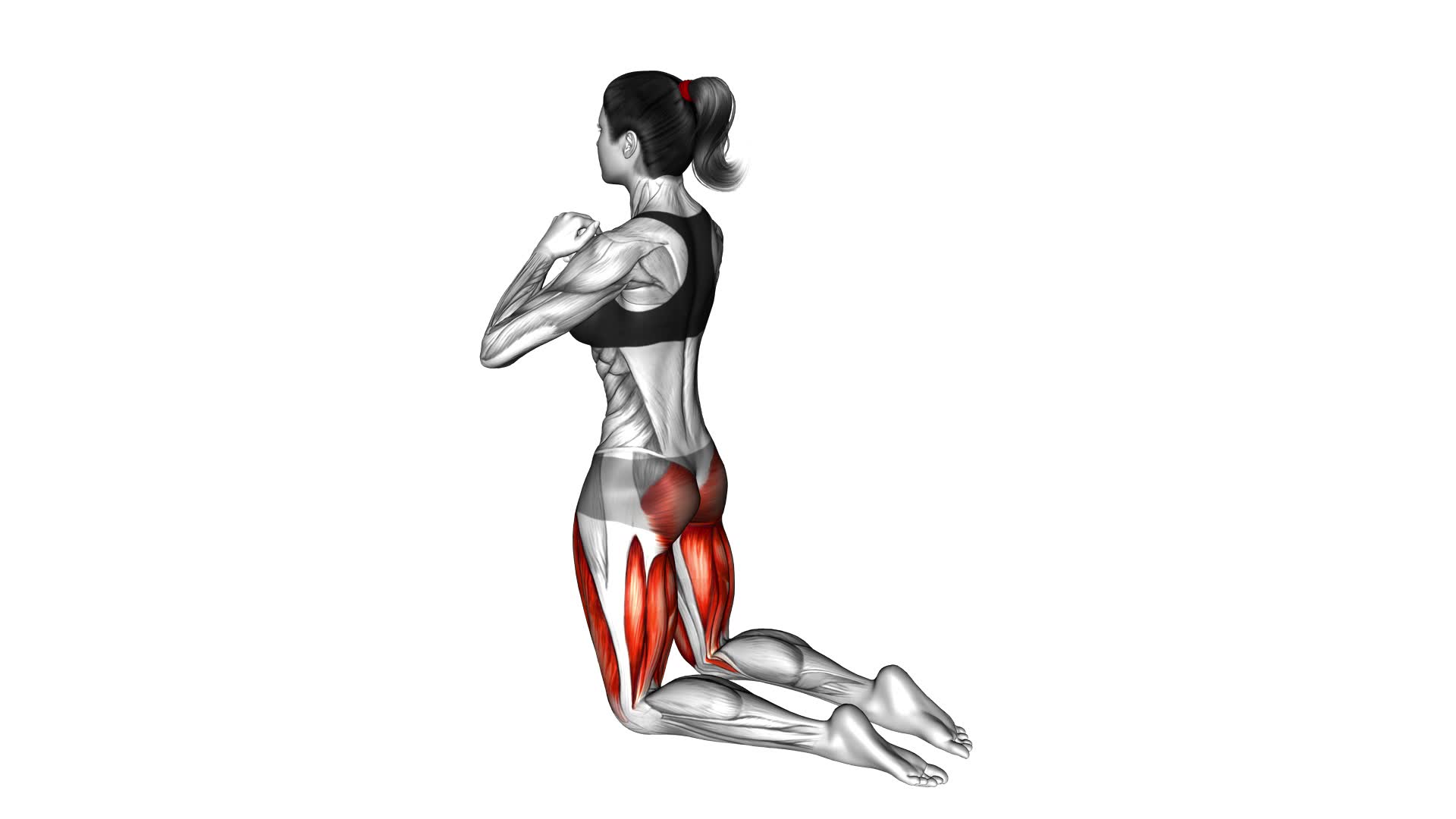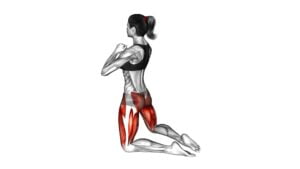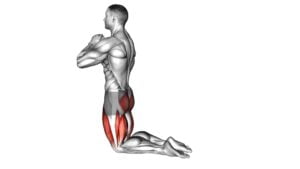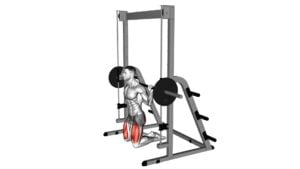Kneeling Hip Thrust (female) – Video Exercise Guide & Tips

Looking to tone and strengthen your glutes? Look no further than the kneeling hip thrust! In this video exercise guide, we'll show you the proper form and technique for performing this effective lower body exercise.
Watch This Exercise Video
You'll also discover variations and progressions to keep challenging yourself. Avoid common mistakes and maximize your results with our helpful tips.
Get ready to feel the burn and achieve your fitness goals with the kneeling hip thrust. Let's get started!
Key Takeaways
- Increased glute and hamstring strength
- Injury prevention and improved stability
- Greater muscle activation and development
- Improved athletic performance and posture
Benefits of the Kneeling Hip Thrust
You will experience increased glute and hamstring strength with the kneeling hip thrust. This exercise isn't only effective for building muscle, but it also provides several benefits related to injury prevention and muscle activation.
One of the key benefits of the kneeling hip thrust is its ability to strengthen your glutes and hamstrings. These muscles play a crucial role in stabilizing your hips and pelvis, which can help prevent injuries such as lower back pain and knee issues. By targeting these muscles, you can improve your overall stability and reduce the risk of injury during other activities or sports.
In addition to injury prevention, the kneeling hip thrust also activates the glutes and hamstrings more effectively than other exercises. This means that you're able to specifically target and engage these muscles, leading to greater muscle activation and development. Strong glutes and hamstrings not only improve your athletic performance but also contribute to better posture and overall body alignment.
Proper Form and Technique
To perform the kneeling hip thrust with proper form and technique, maintain a straight back and engage your core throughout the exercise. Many people have common misconceptions about this exercise, so it's important to know the correct form to maximize its effectiveness and prevent injury.
First, start by kneeling on a mat or soft surface with your knees hip-width apart and your toes pointing forward. Place your hands on your hips or extend your arms out in front of you for balance. Keep your back straight and your shoulders relaxed.
Next, engage your core muscles by pulling your belly button in towards your spine. This will help stabilize your body and protect your lower back. As you thrust your hips forward, squeeze your glutes and push through your heels. Your body should form a straight line from your knees to your shoulders.
It's important to note that modifications and adaptations can be made based on your fitness level and any physical limitations you may have. For example, if you have knee pain, you can place a folded towel or cushion under your knees for added support. You can also use a resistance band or weights to increase the intensity of the exercise.
Variations and Progressions
As you progress with the kneeling hip thrust exercise, you can explore various variations and progressions to challenge your muscles even more. Incorporating advanced modifications and muscle activation techniques can take your workout to the next level.
One advanced modification you can try is adding resistance by using a barbell or dumbbells placed on your hips. This added weight will increase the intensity of the exercise and target your glutes and hamstrings even more effectively.
Another variation is the single-leg kneeling hip thrust, where you perform the exercise with one leg elevated off the ground. This variation requires more stability and activates your glute muscles individually, providing a greater challenge.
To further activate your muscles, you can experiment with different tempos and ranges of motion. Slow down the lowering phase of the movement to increase time under tension and maximize muscle engagement. You can also try pulsing or holding the contraction at the top of the movement to intensify the exercise.
By incorporating these advanced modifications and muscle activation techniques into your kneeling hip thrust routine, you can continue to challenge and strengthen your muscles.
Now, let's move on to the next section and discuss common mistakes to avoid to ensure you're performing this exercise correctly.
Common Mistakes to Avoid
To ensure proper execution of the kneeling hip thrust exercise, it's important to avoid common mistakes. By avoiding these mistakes, you can't only prevent injuries but also maximize targeted muscle activation.
One common mistake is using excessive weight. While adding weight can increase the intensity, using too much weight can compromise your form and increase the risk of injury. It's important to start with a weight that allows you to maintain proper technique throughout the exercise.
Another mistake to avoid isn't maintaining a neutral spine. When performing the kneeling hip thrust, it's crucial to keep your spine in a neutral position to protect your lower back. Avoid arching or rounding your back, as this can lead to strain and potential injury. Engage your core and focus on keeping your spine aligned throughout the movement.
Lastly, rushing through the exercise is another common mistake. It's important to perform the kneeling hip thrust with control and intention. This ensures that you're effectively activating the targeted muscles and reduces the risk of injury. Take your time and focus on the quality of each repetition rather than rushing through the exercise.
Tips for Maximizing Results
Maximize your results by incorporating these tips into your kneeling hip thrust routine.
To improve your hip thrust results, it's essential to pay attention to your nutrition. Ensure you're consuming enough protein to support muscle growth and repair. Aim for a balanced diet that includes lean meats, fish, eggs, legumes, and dairy products. Additionally, staying hydrated is crucial for optimal performance and recovery.
When it comes to incorporating the kneeling hip thrust into your workout routine, it's important to start with proper form. Begin by kneeling on the ground with your back straight and your feet flat on the floor. Place a barbell or a resistance band across your hips, and hold it securely. Engage your glutes and core muscles as you push your hips forward, lifting your body until your thighs are parallel to the ground. Hold the position for a moment, then slowly lower yourself back down.
To maximize your results, gradually increase the weight or resistance as you become stronger. Aim for two to three sets of 10 to 15 repetitions, with a rest period of 30 to 60 seconds between sets. It's also beneficial to vary your workouts by incorporating different variations of the kneeling hip thrust, such as single-leg or banded variations.
Remember to listen to your body and give yourself time to recover between workouts. Consistency is key, so make sure to include the kneeling hip thrust in your routine at least two to three times a week.
Frequently Asked Questions
How Long Does It Typically Take to See Results From Doing the Kneeling Hip Thrust Exercise?
On average, how long does it typically take to see results from doing the kneeling hip thrust exercise?
Well, it depends on various factors such as your fitness level, consistency, and diet. However, incorporating the kneeling hip thrust into your workout routine can bring significant benefits to your glutes and overall lower body strength.
With regular practice, you can start noticing improvements in muscle tone, strength, and stability in a matter of weeks. Remember to stay dedicated and make sure to fuel your body with a nutritious diet for optimal results.
Can I Perform the Kneeling Hip Thrust Exercise if I Have Lower Back Pain?
If you're dealing with lower back pain, it's important to prioritize your comfort and safety. While the kneeling hip thrust exercise may not be the best option for you, there are alternative exercises that can provide lower back pain relief.
It's always a good idea to consult with a healthcare professional or a certified trainer who can guide you in managing your lower back pain and recommend exercises that are suitable for your condition.
Should I Use a Resistance Band or Weights While Performing the Kneeling Hip Thrust Exercise?
To enhance your kneeling hip thrust exercise, you have the option to use either a resistance band or weights. Adding resistance will further challenge your glute muscles and help you achieve better results.
Using a resistance band provides constant tension throughout the movement, while weights allow you to increase the load. Both options have their benefits, so choose what suits you best and remember to maintain proper form for maximum effectiveness.
Is It Necessary to Warm up Before Doing the Kneeling Hip Thrust Exercise?
Before performing the kneeling hip thrust exercise, it's necessary to warm up.
Warming up has many benefits, such as increasing blood flow to your muscles and preparing your body for the upcoming workout.
There are various warm-up techniques you can use, such as light cardio exercises or dynamic stretches.
Can Men Also Benefit From Doing the Kneeling Hip Thrust Exercise?
Yes, men can definitely benefit from doing the kneeling hip thrust exercise. Men's fitness isn't limited to specific exercises or movements.
The kneeling hip thrust is a great exercise for both men and women as it targets the glutes and hip muscles effectively. While there may be some gender differences in terms of strength and muscle development, the benefits of the kneeling hip thrust exercise are applicable to both genders.
Conclusion
In conclusion, the kneeling hip thrust is a highly effective exercise for strengthening and toning the glutes and hamstrings. By maintaining proper form and technique, you can maximize the benefits of this exercise and avoid common mistakes.
Additionally, incorporating variations and progressions can help challenge your muscles and continue to see progress. Remember to follow these tips and guidelines to achieve optimal results from your kneeling hip thrust workouts.

Author
Years ago, the spark of my life’s passion ignited in my mind the moment I stepped into the local gym for the first time. The inaugural bead of perspiration, the initial endeavor, the very first surge of endorphins, and a sense of pride that washed over me post-workout marked the beginning of my deep-seated interest in strength sports, fitness, and sports nutrition. This very curiosity blossomed rapidly into a profound fascination, propelling me to earn a Master’s degree in Physical Education from the Academy of Physical Education in Krakow, followed by a Sports Manager diploma from the Jagiellonian University. My journey of growth led me to gain more specialized qualifications, such as being a certified personal trainer with a focus on sports dietetics, a lifeguard, and an instructor for wellness and corrective gymnastics. Theoretical knowledge paired seamlessly with practical experience, reinforcing my belief that the transformation of individuals under my guidance was also a reflection of my personal growth. This belief holds true even today. Each day, I strive to push the boundaries and explore new realms. These realms gently elevate me to greater heights. The unique combination of passion for my field and the continuous quest for growth fuels my drive to break new ground.







